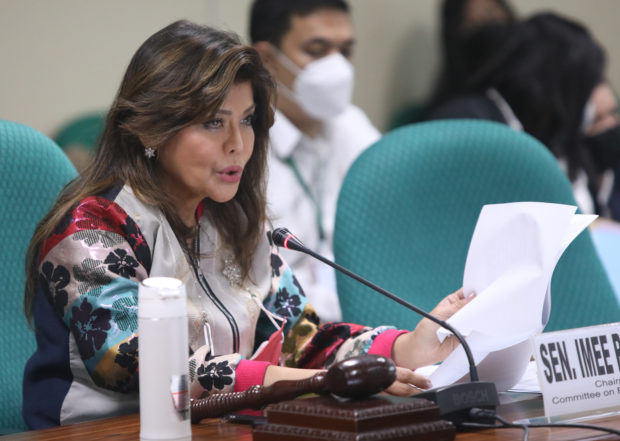
Sen. Imee Marcos during one of the meetings in the Senate. Senate PRIB file photo / Bibo Nueva España
MANILA, Philippines — Senator Imee Marcos has questioned the executive branch on the whereabouts of the surplus harvest of vegetables in the midst of rising prices of goods in the country.
Marcos, in a statement on Wednesday, said that the country has huge surpluses of harvested vegetables, amounting to over 700,000 metric tons (MT) in 2022. However, the senator said that the Department of Agriculture (DA) Supply and Demand Outlook as of December 12 showed that the destinations and end-use of excess vegetables remained unclear.
This means that, Marcos claimed, there may be an unknown degree of food wastage.
“This points to an unknown degree of food wastage and lost income for farmers and savings for consumers. The scenes of vegetables dumped by the roadside or left to rot unsold in trading centers are likely underreported,” Marcos said in a statement.
Marcos said that Department of Agriculture (DA) statistics showed that harvests of highland vegetables like cabbage, carrots, white potatoes, white beans (habichuelas), and Chinese cabbage from the Cordillera Administrative Region (CAR), Cagayan Valley Region, and Northern Mindanao were able to push the country’s total national supply to 1.064 million MT.
This led to a surplus of 642,500 MT or a so-called “sufficiency level” of 252 percent. Marcos also pointed out that CAR on its own had a sufficiency level of 3,195 percent which is around 32 times the amount that people in the region need.
There was also a smaller surplus of 100,993 MT of lowland vegetables in CAR, Cagayan Valley Region, Ilocos Region, Central Luzon, Calabarzon, Bicol Region, and Northern Mindanao, which would provide a sufficiency level of 106 percent.
This could have been enough to feed the country, Marcos said.
“Clearly, there have been more than enough vegetables for everyone’s chopsuey and pinakbet,” Marcos said.
“The problem is not food sufficiency but food mobilization. Farmer-buyer linkages, transport access to deliver farm produce to local trading centers and the bigger cities, and storage facilities to prevent spoilage remain inadequate,” she added.
The country’s agriculture sector has been beleaguered by various issues brought by high prices of produce, which some have attributed to shortage in supply and possibly smuggling, hoarding, and sellers hiding their goods.
Just this Tuesday, DA — which is currently under Marcos’ sister, President Ferdinand Marcos Jr. — admitted that prices of red onions have not gone down from the P300 level despite their plea to producers and growers to sell and release the hidden products.
READ: No drop in red onion prices even after plea to sell hidden produce
Senator Marcos urged the government to engage the private sector to avoid wastage, noting that the Kadiwa stores — market stalls controlled by the government which sells lower-priced vegetables — cannot be enough.
Kadiwa stores were also launched by President Marcos.
READ: Marcos: Kadiwa ng Pasko stores to sell cheaper goods, rice at P25 per kilo
“Private sector engagement must be expanded now and be made systematic and sustainable in the long term to mitigate wastage. The KADIWA program can only do so much, due to its limited budget,” she said.
“Shortages in the Visayas could have been covered by surpluses from Luzon and Northern Mindanao, with much to spare, if an efficient supply chain was in place. The DA’s challenge lies in greater food mobilization. Beyond minimizing food wastage, jobs in farming will also be saved and new ones created in transport and delivery, possibly even in export,” she added.